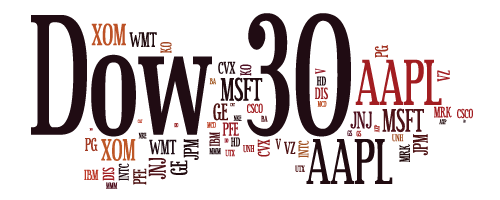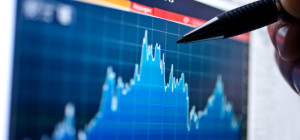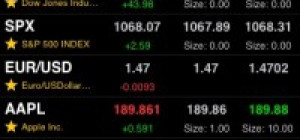The Dow 30, or Dow Jones Industrial Average (DJIA), is an illustration of the changes in the U.S. economy since its launch in 1896. The index was originally created by Wall Street Journal editor Charles Dow, and his business associate, Edward Jones, to track the stock prices of the largest companies in each industrial sector.

When the Dow was first published, 12 companies were represented, but as the economy has changed, so has the index. In 1928, the number of stocks included in the average increased to 30 to reflect the diverse sectors in the market. General Electric are the only company to remain in the Dow 30 since this time, with other companies entering and leaving as their value has fluctuated. Today, the Dow 30 is made up of recognisable household names such as Apple, Coca-Cola, McDonald’s and Nike.
Here’s the current list of the 30 component companies that make up the Dow index:
| Apple Inc. | Home Depot | Nike Inc. |
| American Express | IBM Corp | Pfizer |
| Boeing Co. | Intel Corp | Procter & Gamble |
| Caterpillar Inc. | Johnson & Johnson | Travelers Co. |
| Cisco Systems | JP Morgan Chase | UnitedHealth Group |
| Chevron Corp | Coca-Cola Co. | United Technologies |
| DuPont | McDonald’s | Visa |
| The Walt Disney Company | 3M | Verizon |
| General Electric | Merck | Wal-Mart Stores |
| Goldman Sachs | Microsoft | Exxon Mobil |
The components have changed over 50 times since the Dow’s inception and the companies which now make up the index are very different to those of the past. And the components are expected to continue to adjust as new upcoming industries contribute to the U.S. economy. Cisco Systems, for example, wasn’t founded until 1984 but the company has seen rapid growth and is the first Dow component to symbolise the rise of the Internet.
So, how does the Dow 30 index work? You’ll have heard news readers informing us of the latest position of the index, either being up or down a couple of points, but what does this mean? Well, back when the Dow was first introduced, the stocks of all included companies was simply added up and divided by 12. But, as the world of stocks and shares has become more complicated, it has been necessary to develop something called a Dow divisor. This number considers stock splits and stock dividends and is continually updated to reflect the changes. To calculate the Dow, the current stock prices of the 30 component companies are added together and then divided by the Dow divisor.
Along with the FTSE 100 index in London and the Nikkei 225 in Tokyo, the Dow is one of the most observed indicators for stock market performance, and is a good indication of the health of the U.S. economy. However, it has been criticised for several reasons. Because there are only 30 Dow stocks in the index, a single component has the power of changing the daily performance of the Dow if its share price fluctuates considerably. Additionally, as the index is price-weighted it gives higher-priced stocks more influence over the average than lower-priced stocks, but does not consider the relative industry size of the components. This means that it doesn’t always give investors a true view of the market’s performance.
These criticisms have led to some investors choosing to use the Standard and Poor’s 500 (S&P 500), another U.S. index, as a measurement to determine the strength of the U.S. stock market. Not only does the S&P 500 include a greater number of U.S. stocks, it’s also a market value-weighted index. This means that a 10% change in a low-priced stock affects the index as much as a 10% change in higher-priced stock. This is something that the price-weighted method of the Dow does not achieve.
As well as stock price variations, there are other external factors that can impact the stock market too. Unsurprisingly, the devastation of the September 11th attacks on the country were reflected negatively in the index. When the market re-opened 8 days after the attacks, the Dow had fallen by over 7% – the eighth worst day since the Dow was created. The Dow continued to drop down by 15% over the next 5 days. This event contributed to the start of the recession of the early 2000s.
It’s true that major events can have an adverse effect on the Dow, but it’s not always a given. This was demonstrated in March 1981 when President Ronald Regan was shot. It would be logical to think that the attempted assassination would force the Dow to plummet, but the stock markets were closed before they could fall and then rose 7% in the following week. This should be considered by long-term investors. Although major events do play their part in the performance of the Dow, it’s not necessarily the negative impact that’s presumed.







